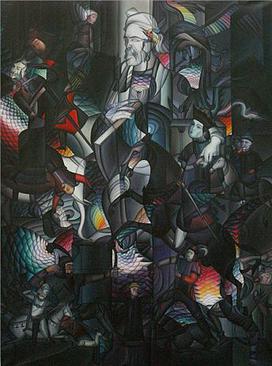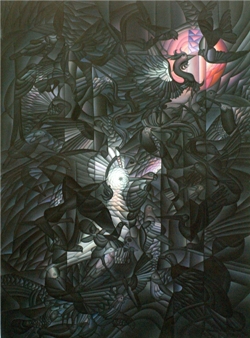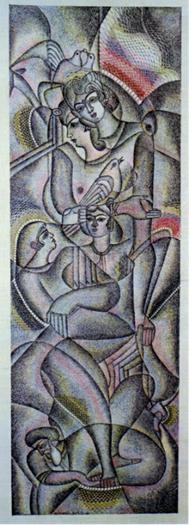Bahram Alivandi facts for kids
Bahram Alivandi (1928 – 21 May 2012) was an artist from Iran who later lived in Austria. He was famous for his modern paintings. His art often showed stories from old Persian myths and books. He also made beautiful wall tapestries. He lived in Vienna, Austria, from 1983 until he passed away in 2012.
Contents
Bahram Alivandi's Life Story
Alivandi was born in Fars Province, Iran, in 1928. He learned art in Tehran. First, he studied at the Kamal-ol-Molk Academy of Art. Then, he went to Tehran's School of Fine Arts, which was like a famous art school in France. He did very well there! He also got another degree in painting.
In 1959, he started teaching painting at the Workshop of National Art and the Kamal-ol-Molk Academy. He taught for 20 years. During this time, he practiced many traditional Persian arts. These included miniature painting, making pottery, weaving tapestries, and working with silver.
Alivandi was one of Iran's top modern artists. But in 1983, he left Iran. This was a few years after the Iranian Revolution of 1979. He left to escape problems like censorship, which meant he couldn't always express himself freely. He lived and worked in Vienna from 1983 until he died on May 12, 2012.
Alivandi is part of a respected group of Iranian artists. These artists are important in modern Iranian art. Some of them include Massoud Arabshahi, Nasser Ovissi, and Parviz Tanavoli.
Alivandi's Unique Art Style
Alivandi's art is full of special symbols and designs. You might see fish, gazelles, and horses. These are common in traditional Persian miniature paintings. He was very inspired by Persian culture. He painted characters and stories from old legends and poems. Important writers like Ferdowsi and Farid ad-Din Attar influenced him.
Some of his famous works are large oil paintings from the 1980s. They show important figures like Mithra, Jesus Christ, the Simorgh (a mythical bird), and Ferdowsi himself. Some of his art also shows the pain and suffering of his people. This was influenced by the war and problems in his home country, Iran.
Alivandi used both traditional and very original techniques. His early paintings, including those from the 1980s, used oil paints on canvas. This is a traditional way to paint. But his style was very personal, almost like the stained glass in old churches. In the 1990s, he still used oils but painted directly onto newspapers! This was a new idea, first used by artists called Cubists in the early 1900s.
Since about 2000, he started using a special technique called angelique pointillage. This is a unique way of painting with tiny dots of ink. Then, he covered them with a layer of veneer. This made the colors stronger and brighter. This new pointillist technique created many amazing works. They show how beautiful his art is and how powerful his ideas were. One art critic even called him "the magician of colours" because he was so good at mixing hues.
Alivandi's paintings are usually very big. Even so, they show amazing detail. This proves how skilled he was as an artist.
Exhibitions of Alivandi's Art
Alivandi's art has been shown all over Europe and Asia. It has received great praise from art critics. Here are some important recent exhibitions:
- Solo Shows:
- His work was shown at the Headquarters of the United Nations in Vienna.
- In June 2007, he had a show in Vienna called 'Art in Exile'. It featured 73 of his works, including watercolors, oil paintings, and drawings on paper.
- Group Shows:
- In 2008, a very important exhibition in Vienna was organized by UNESCO. It included Ferdowsi, a key painting by Alivandi. This painting shows the Shahnameh, a huge poem written by the Iranian poet Ferdowsi around 1000 CE. It's like the national epic story for people who speak Persian.
- In December 2007, Alivandi's art was shown with two French artists at Galerie Art Présent in Paris. This is one of Paris's best modern art galleries. After the show, a French article said that Alivandi's art was unique. It said he combined his European training with his deep knowledge of Persian art and spirit. This created a "new genre" that was only his. The critic also called his paintings a "paradise of dots."
Awards and Prizes




